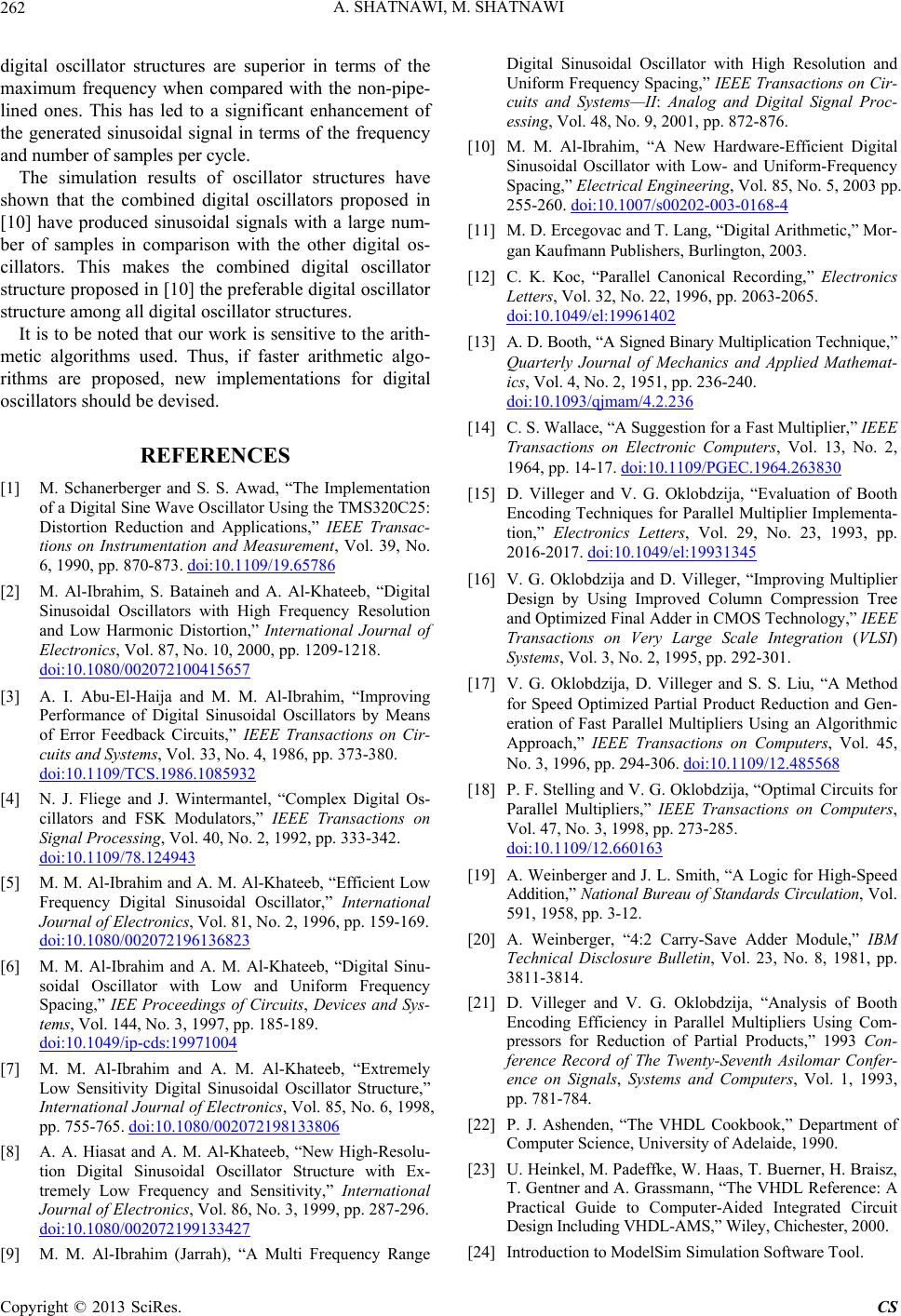
A. SHATNAWI, M. SHATNAWI
262
igital oscillator str
llator structures h
sh
e arith-
m
[1] M. Schanerbehe Implementation
ductures are superior in terms of the
maximum frequency when compared with the non-pipe-
lined ones. This has led to a significant enhancement of
the generated sinusoidal signal in terms of the frequency
and number of samples per cycle.
The simulation results of osciave
own that the combined digital oscillators proposed in
[10] have produced sinusoidal signals with a large num-
ber of samples in comparison with the other digital os-
cillators. This makes the combined digital oscillator
structure proposed in [10] the preferable digital oscillator
structure among all digital oscillator structures.
It is to be noted that our work is sensitive to th
etic algorithms used. Thus, if faster arithmetic algo-
rithms are proposed, new implementations for digital
oscillators should be devised.
REFERENCES
rger and S. S. Awad, “T
of a Digital Sine Wave Oscillator Using the TMS320C25:
Distortion Reduction and Applications,” IEEE Transac-
tions on Instrumentation and Measurement, Vol. 39, No.
6, 1990, pp. 870-873. doi:10.1109/19.65786
[2] M. Al-Ibrahim, S. Bataineh and A. Al-Khateeb, “Digital
Sinusoidal Oscillators with High Frequency Resolution
and Low Harmonic Distortion,” International Journal of
Electronics, Vol. 87, No. 10, 2000, pp. 1209-1218.
doi:10.1080/002072100415657
[3] A. I. Abu-El-Haija and M. M. Al-Ibrahim, “Improving
Performance of Digital Sinusoidal Oscillators by Means
of Error Feedback Circuits,” IEEE Transactions on Cir-
cuits and Systems, Vol. 33, No. 4, 1986, pp. 373-380.
doi:10.1109/TCS.1986.1085932
[4] N. J. Fliege and J. Wintermantel, “Complex Digital Os-
cillators and FSK Modulators,” IEEE Transactions on
Signal Processing, Vol. 40, No. 2, 1992, pp. 333-342.
doi:10.1109/78.124943
[5] M. M. Al-Ibrahim and A. M. Al-Khateeb, “Efficient Low
Frequency Digital Sinusoidal Oscillator,” International
Journal of Electronics, Vol. 81, No. 2, 1996, pp. 159-169.
doi:10.1080/002072196136823
[6] M. M. Al-Ibrahim and A. M. Al-Khateeb, “Digital Sinu-
soidal Oscillator with Low and Uniform Frequency
Spacing,” IEE Proceedings of Circuits, Devices and Sys-
tems, Vol. 144, No. 3, 1997, pp. 185-189.
doi:10.1049/ip-cds:19971004
[7] M. M. Al-Ibrahim and A. M. Al-Khateeb, “Extremely
Low Sensitivity Digital Sinusoidal Oscillator Structure,”
International Journal of Electronics, Vol. 85, No. 6, 1998,
pp. 755-765. doi:10.1080/002072198133806
[8] A. A. Hiasat and A. M. Al-Khateeb, “New High-Resolu-
tion Digital Sinusoidal Oscillator Structure with Ex-
tremely Low Frequency and Sensitivity,” International
Journal of Electronics, Vol. 86, No. 3, 1999, pp. 287-296.
doi:10.1080/002072199133427
[9] M. M. Al-Ibrahim (Jarrah), “A Multi Frequency Range
High Resolution and
rm-Frequency
Digital Sinusoidal Oscillator with
Uniform Frequency Spacing,” IEEE Transactions on Cir-
cuits and Systems—II: Analog and Digital Signal Proc-
essing, Vol. 48, No. 9, 2001, pp. 872-876.
[10] M. M. Al-Ibrahim, “A New Hardware-Efficient Digital
Sinusoidal Oscillator with Low- and Unifo
Spacing,” Electrical Engineering, Vol. 85, No. 5, 2003 pp.
255-260. doi:10.1007/s00202-003-0168-4
[11] M. D. Ercegovac and T. Lang, “Digital Arithmetic,” Mor-
gan Kaufmann Publishers, Burlington, 2003.
[12] C. K. Koc, “Parallel Canonical Recording,” Electronics
Letters, Vol. 32, No. 22, 1996, pp. 2063-2065.
doi:10.1049/el:19961402
[13] A. D. Booth, “A Signed Binary Multiplication T
Quarterly Journal of Mec
echnique,”
hanics and Applied Mathemat-
ics, Vol. 4, No. 2, 1951, pp. 236-240.
doi:10.1093/qjmam/4.2.236
[14] C. S. Wallace, “A Suggestion for a Fast
Transactions on Electronic
Multiplier,” IEEE
Computers, Vol. 13, No. 2,
1964, pp. 14-17. doi:10.1109/PGEC.1964.263830
[15] D. Villeger and V. G. Oklobdzija, “Evaluation of Booth
Encoding Techniques for Parallel Multiplier Implementa-
tion,” Electronics Letters, Vol. 29, No. 23, 1993, pp.
2016-2017. doi:10.1049/el:19931345
[16] V. G. Oklobdzija and D. Villeger, “Improving Multiplier
Design by Using Improved Column Compression Tree
tion and Gen-
and Optimized Final Adder in CMOS Technology,” IEEE
Transactions on Very Large Scale Integration (VLSI)
Systems, Vol. 3, No. 2, 1995, pp. 292-301.
[17] V. G. Oklobdzija, D. Villeger and S. S. Liu, “A Method
for Speed Optimized Partial Product Reduc
eration of Fast Parallel Multipliers Using an Algorithmic
Approach,” IEEE Transactions on Computers, Vol. 45,
No. 3, 1996, pp. 294-306. doi:10.1109/12.485568
[18] P. F. Stelling and V. G. Oklobdzija, “Optimal Circuits for
Parallel Multipliers,” IEEE Transactions on Computers,
Vol. 47, No. 3, 1998, pp. 273-285.
doi:10.1109/12.660163
[19] A. Weinberger and J. L. Smith, “A L
Addition,” National Bure
ogic for High-Speed
au of Standards Circulation, Vol.
Bulletin, Vol. 23, No. 8, 1981, pp.
ficiency in Parallel Multipliers Using Com-
ence, University of Adelaide, 1990.
e: A
591, 1958, pp. 3-12.
[20] A. Weinberger, “4:2 Carry-Save Adder Module,” IBM
Technical Disclosure
3811-3814.
[21] D. Villeger and V. G. Oklobdzija, “Analysis of Booth
Encoding Ef
pressors for Reduction of Partial Products,” 1993 Con-
ference Record of The Twenty-Seventh Asilomar Confer-
ence on Signals, Systems and Computers, Vol. 1, 1993,
pp. 781-784.
[22] P. J. Ashenden, “The VHDL Cookbook,” Department of
Computer Sci
[23] U. Heinkel, M. Padeffke, W. Haas, T. Buerner, H. Braisz,
T. Gentner and A. Grassmann, “The VHDL Referenc
Practical Guide to Computer-Aided Integrated Circuit
Design Including VHDL-AMS,” Wiley, Chichester, 2000.
[24] Introduction to ModelSim Simulation Software Tool.
Copyright © 2013 SciRes. CS